15 janvier 2012 Adalah-NY
Le gaz lacrymogène fabriqué par des entreprises telles que Combined Systems Inc. (CSI), Defense Technology, and nonlethal Technologies, continue d’être utilisé par les gouvernements dont l’Égypte, Israël, le Yémen, Bahreïn et les États-Unis pour réprimer les mouvements de protestation populaires en faveur de la justice sociale
En réponse, les avocats défenseurs des droits de l’homme protesteront à nouveau pour la journée de Martin Luther King Jr, le 16 janvier 2012, devant le quartier général de la CSI à Jamestown, Pennsylvanie (voir pastProtests against Israel lacrymogène use). Avant la manifestation, les rapports indiquent que le CSI a remplacé le drapeau israélien qui flottait précédemment aux côtés du drapeau américain à l’extérieur de son siège avec un drapeau de l’État de Pennsylvanie.
Des preuves solides que la cartouche du CSI a tué le manifestant palestinien Mustafa Tamimi :
Le 9 décembre 2011, dans le village de Nabi Saleh en Cisjordanie, un soldat israélien à l’intérieur d’une jeep militaire blindée a tiré une cartouche de gaz lacrymogène à bout portant directement au visage du manifestant palestinien Mustafa Tamimi venu manifester contre l’expansion des colonies israéliennes sur les terres de Nabi Saleh. Mustafa est mort de la suite de ses blessures le jour suivant. Les manifestants n’ont pas réussi à collecter la cartouche de gaz lacrymogène réelle tiré sur lui. Cependant, les habitants de Nabi Saleh ont collecté des échantillons des types de cartouches de gaz lacrymogène que l’armée israélienne utilise contre les manifestations hebdomadaires de Nabi Saleh, y compris le type spécifique de cartouche de gaz lacrymogène – de la même taille et de la même forme – qui a frappé Mustafa. Le type de cartouche qui a tué Mustafa peut être vu dans les 11 et 13 janvier 2012, photos ci-dessous prises à Nabi Saleh par Bilal Tamimi. La boîte porte un cachet qui indique CTS. CTS signifie Combined Tactical Systems, un nom de marque de Combined Systems Inc., à Jamestown, en Pennsylvanie. Adalah-NY a reçu ces photos du Comité de Coordination de la Lutte Populaire.

Une pièce d’une cartouche de gaz lacrymogène de Nabi Saleh, comme celle qui a tué Mustafa Tamimi, estampillée CTS – 13 janvier 2012, photo de Bilal Tamimi.
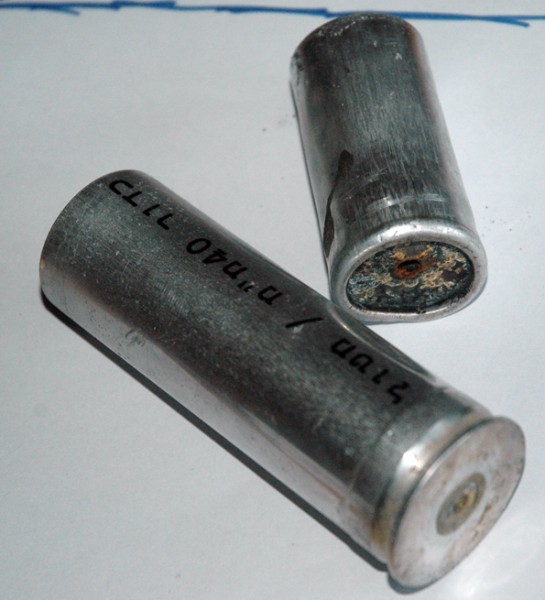
Les deux morceaux d’une cartouche de gaz lacrymogène de Nabi Saleh, comme celle qui a tué Mustafa Tamimi, estampillée, CTS – Photo du 11 janvier 2012 par Bilal Tamimi
Des cartouches du CSI et des gaz lacrymogènes, tiré par des soldats israéliens lors de manifestations contre les colonies israéliennes et le mur sur les terres palestiniennes, ont également causé la mort des manifestants Bassem et Jawaher Abu Rahmah à Bil’in, la blessure grave du manifestant Tristan Anderson, un citoyen américain, à Ni’lin, ainsi que des blessures graves à de nombreux autres manifestants palestiniens.
Le CSI est le principal fournisseur de gaz lacrymogène à l’armée israélienne ainsi qu’un fournisseur à la police israélienne (et la police des frontières). Jusqu’au changement de son site Web en janvier 2012 où le CSI a énuméré les industries militaires israéliennes et Rafael Armament Development Authority comme parmi ses clients militaires et partenaires de développement (voir l’ancienne page Web). Les fondateurs de CSI, Jacob Kravel et Michael Brunn, sont israélo-américains.
En plus des cartouches omniprésentes du CSI/CTS trouvées lors des manifestations palestiniennes, les preuves de ventes et d’expéditions du CSI vers Israël sont claires. Le 30 avril 2008, Wikileaks du département d’État américain à Washington DC au département d’État des États-Unis à Tel-Aviv demande à la police d’Israël de lui envoyer l’équipement suivant : 1 000 grenades à main en caoutchouc, 1 000 grenades tactiques Flash Bang, 1 000 grenades Sting-Ball, 1 000 Flash Bang Training et 1 000 sacs de fèves Super-Sock. La cargaison faisait partie d’un accord de 5 millions de dollars entre la police israélienne et le CSI. Un site web du gouvernement israélien montre que le 4 août 2011, la police israélienne a acheté 6 millions de shekels (1,56 million de dollars) de grenades assommantes au CSI sans lancer d’appel d’offres.
La base de données PIERS sur les exportations des activités commerciales des États-Unis est utile pour identifier les expéditions de gaz lacrymogènes vers un certain nombre de pays, dont l’Égypte, la Tunisie et l’Algérie (voir plus bas). Cependant, la recherche PIERS ne montre pas les expéditions du CSI à Israël. La photo d’un conteneur du CSI ci-dessous révèle deux preuves. L’étiquette au bas de la photo montre que le conteneur de gaz lacrymogène a été expédié par la compagnie aérienne nationale israélienne El Al, et PIERS ne suit que les expéditions par voie maritime. En outre, l’étiquette du bas montre que le conteneur du CSI a été envoyé au ministère de la Défense d’Israël par Interglobal Forwarding Services, à Bayonne, New Jersey. Une recherche sur PIERS pour Interglobal Forwarding Services au cours de la dernière année montre plus de 1.300 expéditions, dont certaines évidemment gaz lacrymogène, par Interglobal des États-Unis à Israël
La société américaine Defense Technology a également fourni des gaz lacrymogènes à la police israélienne (voir les informations sur la technologie de défense au Moyen-Orient et à Oakland ci-dessous, et une photo d’un conteneur de gaz lacrymogène de Defense Technology à Jérusalem ci-dessous).
Le gaz lacrymogène du CSI tue et blesse les manifestants égyptiens :
Le gaz lacrymogène du CSI est également le principal gaz lacrymogène utilisé par les forces de sécurité égyptiennes pour réprimer les protestations populaires en faveur de la démocratie en Égypte au cours de la dernière année, causant la mort et les blessures des manifestants. Amnesty International a souligné l’envoi de gaz lacrymogène du CSI en Égypte dans son appel au 6 décembre 2011 pour que le gouvernement américain cesse d’envoyer des gaz lacrymogènes et des armes au gouvernement égyptien en raison des gaz lacrymogènes. . .décès et blessures liés à des manifestants égyptiens. En utilisant la base de données PIERS, Amnesty International a documenté trois cargaisons spécifiques de gaz lacrymogène du CSI aux États-Unis vers l’Égypte en 2011 qui ont été approuvées par le département d’État américain, malgré le fait que les forces de sécurité égyptiennes utilisent des gaz lacrymogènes pour tuer et blesser les manifestants dans leurs efforts pour écraser les manifestations.
Comme documentation supplémentaire, un 11 juillet 2008, câble du département d’État à Washington DC au département d’État au Caire disponible via Wikileaks demande des informations pour finaliser l’expédition de CSI au ministère égyptien de l’Intérieur de 20,000 grenades CS Smoke Hans, 20 000 cartouches CS Smoke Long Range et 4 0000 cartouches pénétrantes CS Window, pour une valeur totale de 621 000 $.
Le CSI au Moyen-Orient et dans le monde :
Les conteneurs du CSI ont également été vus (par exemple à 27 secondes dans cette vidéo tunisienne) et blâmés pour la mort des manifestants en Tunisie. La base de données PIERS révèle un envoi de 5,540 kilogrammes « de cartouches, de grenade » et « de lance-munitions » à destination de la Tunisie le 1er avril 2010. PIERS montre également un envoi de 12 663 kilogrammes de « munitions » pour l’Algérie le 8 avril 2011. Il y a des preuves de l’utilisation de gaz lacrymogènes par le gouvernement yéménite contre les manifestants.
La technologie de défense au Moyen-Orient et à Oakland :
Un rapport de Corporate Watch montre que la société américaine Defense Technology a fourni des gaz lacrymogènes à la police israélienne. Defense Technology a son siège social à Casper, dans le Wyoming, et appartient au géant britannique des armes BAE Systems. BAE Systems est également propriétaire de la société d’armement américaine Armor Holdings et a acheté Federal Laboratories, une autre société américaine qui fournissait des gaz lacrymogènes à Israël et à d’autres pays, et qui a fait l’objet de protestations et de poursuites lors de la première intifada (Voir la section sur les décès passés dus aux gaz lacrymogènes israéliens).
Des bidons de gaz lacrymogènes avec la technologie de défense et les laboratoires fédéraux ont également été utilisés par les gouvernements yéménite et égyptien contre les manifestants pro-démocratie.
La ville d’Oakland a également utilisé le gaz lacrymogène Defense Technology dans ses efforts pour arrêter les manifestations populaires par Occupy Oakland. Le manifestant d’Oakland Scott Olsen, un ancien marine américain, a été grièvement blessé lorsqu’il a été frappé à la tête par un projectile de la police d’Oakland, très probablement fabriqué par Defense Technology.
Approbation et financement des expéditions de gaz lacrymogène par le gouvernement américain :
Il existe des documents clairs et la confirmation par le département d’État que le département d’État approuve les ventes de gaz lacrymogène à des gouvernements étrangers par des sociétés américaines sous le nom de « ventes commerciales directes ». Une page Web du département d’État des États-Unis présente de nombreux ex
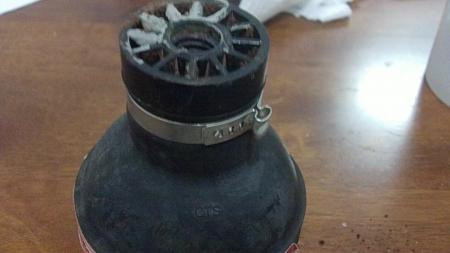
Le gaz lacrymogène peut être gravé propane CTS, ramassé lors de la manifestation de Bil’in le 31 décembre 2010, le jour où Jawaher Abu Rahmah a été submergé par des gaz lacrymogènes. Elle est morte le lendemain.
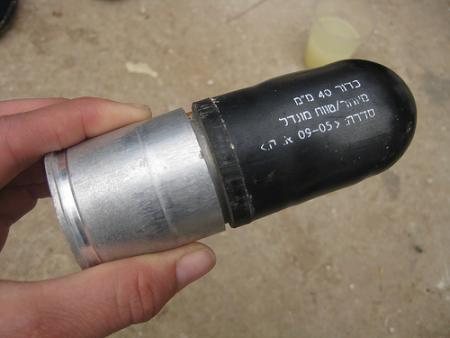
Une cartouche de gaz lacrymogène longue portée, tiré sur des manifestants à Ni’lin en 2009. Le CSI a étendu la portée des tubes comme celui qui a tué Bassem Abu Rahmah, et a gravement blessé Tri stan Anderson et de nombreux autres manifestants palestiniens.
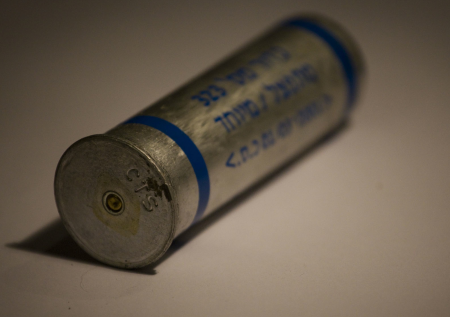
En 2009, cartouche de gaz lacrymogène tiré sur les manifestants à Bil’in, avec l’estampille CTS – Photo d’ActiveStills.
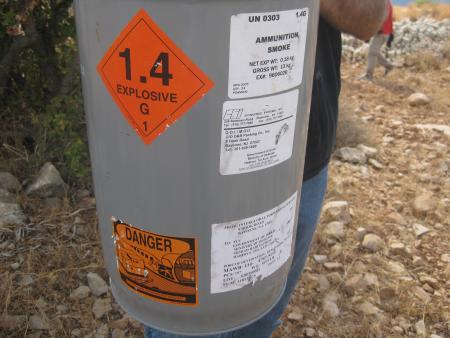
Conteneur pour cartouches de gaz lacrymogène CSI tiré sur des manifestants à Ni’lin en 2009. L’information sur l’expédition est incluse sur les étiquettes

du Corporate Rapport de surveillance – « Conteneur Defense Technologies transporté par la police à Jérusalem-Est en mars 2009 – Photos courtoisie des activistes israéliens